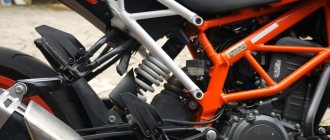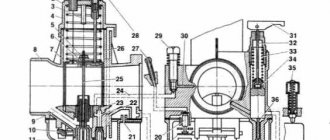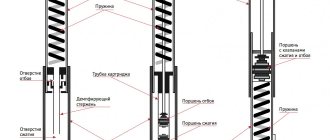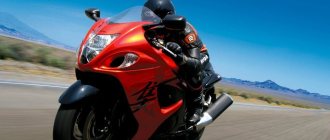Among all the maintenance work on two-wheeled vehicles, adjusting the motorcycle suspension occupies a special place. It allows you to ensure maximum safety for the rider and improve the capabilities of the equipment, since the stability of the motorcycle depends on the correct settings of the chassis. In theory, adjusting the suspension should take a minimum of time and effort, since it only allows you to change six basic parameters. However, practice shows that such work requires long hours and even days spent studying instructions, expert recommendations and test runs. We will tell you how to properly adjust the suspension of a two-wheeled vehicle so as not to encounter problems in any driving mode.
Basic adjustments
The main parameter that you have to change when setting up the suspension is spring preload. It is installed based on the sagging of the motorcycle in two positions - under its own weight and under the weight of the rider. It is worth understanding that the amount of sag directly depends on the length of suspension travel - for a road motorcycle it should be equal to 20–30% of this figure. The sagging of a motorcycle under its own weight should be in the range of 5–10% of the suspension travel. Therefore, for a sportbike with suspension travel of 120–130 mm, the sag value under its own weight will be 7–15 mm, and under the driver’s weight – 25–40 mm.
Spring preload adjustment is done using special nuts that are located on top of the main chassis components. On the fork they are located on top of the stay tubes, but on the rear monoshock absorber they are located in its upper part, next to the base of the spring. To adjust the suspension, you will need a standard hex wrench - it is advisable to use a new tool that will not slip, disrupting the optimal parameters.
To set the correct suspension settings, you need to measure the sag of the motorcycle in two positions (racers call these values free sag and driver sag, respectively). First, you should place the motorcycle on a special repair stand or on a large concrete block in order to evenly hang both wheels. Now you need to select the point from which the measurement will be taken. At the rear, it is best to place a mark on any noticeable element of the cladding, and at the front - on the lantern or on the lower edge of the windshield.
You need to measure the distance not to the tire, but to the wheel axle, so that the results are as accurate as possible. After recording the results, lower the motorcycle to the ground and repeat the measurement - you should get a difference of the same 7-15 mm if we are talking about road vehicles. For the third measurement, you will need an assistant to take measurements and take notes.
After first unloading the wheels, place the motorcycle back on the ground, and then jump on it, swinging to achieve compression on both parts of the suspension. Sit up straight and put your feet on the footrests - you can hold on to the wall with your hand so as not to fall. At this time, the assistant should take the required measurements and record the results. The procedure should be performed three times, each time hanging the motorcycle and lowering it down - the cause of the error may be excess friction in the fork, so the end result will be the arithmetic average of these three measurements. Remember that when further adjusting the suspension, you should not touch the preload adjustment, as otherwise you risk making your motorcycle uncontrollable.
Yamaha PW50
The Yamaha PW50 model is a mini-bike designed specifically for teenagers, but its characteristics are not inferior to “adult” cross-country and enduro models. The 50 cc two-stroke air-cooled engine with a Mikuni VM12/1 carburetor develops a power of 2.7 hp. and a torque of 3.8 Nm. An automatic transmission with a centrifugal automatic clutch makes it easy to control the motorcycle, which has a gross weight of 39 kg. To prevent accidents, there is a gas limiter on the handle, and the spinal frame is welded from powerful steel pipes.
The motorcycle's suspension - a telescopic fork with 60 mm travel at the front and a swingarm with 50 mm travel at the rear - allows it to conquer even minor off-road conditions. Considering that the bike will be driven by a teenager and the fact that there is a speed limiter, drum brakes are installed instead of disc brakes.
Fine tuning
We've dealt with springs, now it's time to move on to shock absorbers, which play an equally important role in the operation of the chassis of a two-wheeled vehicle. Modern motorcycles have two damping adjustments, which are responsible for low-speed and high-speed operation of the shock absorber. This is not at all about the speed at which the vehicle moves, but about the pace of movement of the shock absorber rod - low-speed movement corresponds to sagging during acceleration and sudden braking, as well as during turns, while high-speed movement allows you to dampen vibrations caused by driving on a road with poor surfaces.
As a rule, adjusting the motorcycle suspension in terms of damping is done using wrenches of various sizes. The nuts used to adjust the suspension are located on one plug - inside there is one that is responsible for the slow operation of the shock absorber, and on the outside for fast compression. Their parameters may not depend on each other in any way. So, if you want to achieve greater stability, while sacrificing comfort, you should tighten the nut, which is responsible for the low-speed operation of the suspension, as tightly as possible. If you are going to drive on rough roads, you need to unscrew the high-speed setting nut - and, conversely, for track riding it should be tightened almost to the maximum position.
Since getting the damping settings right is such a difficult job, it's a good idea to start with a mid-position setting. If there are no numbers on the nuts, you should tighten them to the maximum position, and then gradually loosen them, counting the number of clicks. When the suspension is in the softest position, you need to divide the number of clicks by 2 and tighten the nuts in accordance with the calculation result. After driving a couple of kilometers with medium settings, listen to your feelings and write them down on paper, dividing them into positive and negative - this will help highlight the main shortcomings of the selected suspension parameters.
The disadvantages of tuning can be very different, but there are only two reasons for their occurrence - too hard or too soft damping of vibrations by shock absorbers. In the first case, you need to unscrew the low-speed suspension nut, and in the second, tighten it. Let's consider in what cases these actions should be performed - for convenience, we will put the main disadvantages of the selected settings in the table:
| Situation | Insufficient damping (nut needs to be tightened) | Excessive damping (need to loosen nut) |
| Front suspension compression | Slow reactions to turning the steering wheel, inability to correct the trajectory when tilting strongly. Rapid sagging of the motorcycle towards the front wheel during sudden braking. Perceptible breakdown of the fork when driving over large irregularities. | Strong rye on the steering wheel. When driving over bumps, shocks are observed that reverberate unpleasantly in the driver's hands. The motorcycle bounces on poor surfaces, making it very difficult to maintain a stable position. There is no sag towards the front wheel when braking. |
| Front suspension rebound | When hitting any bumps, strong shaking begins. In fairly sharp turns, which the vehicle goes through at an angle, it first tries to go onto a wider trajectory, and then returns to the desired line. | When accelerating hard, the front wheel may lose contact with the asphalt surface. When driving over bumps, the fork vibrates strongly and may deviate to the side. When accelerating into a corner, the motorcycle begins to slide outward. |
| Rear suspension compression | On uneven surfaces, the chassis often breaks, which leads to a decrease in comfort. The steering is slow due to the constant sinking of the rear wheel during acceleration. The motorcycle sways quite a lot when accelerating. | When accelerating, the rear suspension of the motorcycle practically does not sag. The rear wheel bounces when driving over uneven surfaces; when cornering, the motorcycle often leaves the chosen trajectory. When accelerating, impacts and other unpleasant sensations intensify significantly. |
| Rear suspension rebound | At high speed, the motorcycle sways strongly, and it is impossible to maintain a stable trajectory. When cornering, the motorcycle bounces, and the first signs of rear wheel skidding appear. | When braking in a corner, the rear wheel begins to slide to the outside of the curve. The suspension is very stiff; when driving over any uneven surfaces, shocks and other unpleasant sensations appear. |
It is worth remembering that setting extreme settings, for example, the hardest or softest, is unacceptable. This means that the motorcycle suspension is already working in extreme mode and its wear will be very high. In addition, the slightest weakening of the springs as a result of changes in the rigidity of the metal will lead to improper operation of the chassis. Therefore, in this case it is necessary to use alternative adjustment schemes.
Shock absorber
Any spring, if compressed and then released, begins to vibrate. The main task of a shock absorber in a suspension is to dampen (absorb) spring vibrations. The shock absorber converts the vibration energy of the spring into thermal energy (the fluid inside the shock absorber heats up, after which the heat is dissipated).
Properly selected and adjusted suspension components can significantly improve handling. At the same time, a faulty suspension can cause a sharp deterioration in the behavior of the motorcycle. The suspension must always be in good condition.
How else is the suspension adjusted?
In some cases, you may simply not be able to find the nuts mentioned above for adjusting your motorcycle suspension. It is worth carefully reading the factory operating instructions for two-wheeled equipment - it is quite possible that the adjustment controls are located in a different place, and you simply did not see them the first time. However, there are also motorcycles in which the suspension adjustment is carried out according to other schemes in which adjusting nuts are not used. In addition, they are resorted to when the range of factory settings has been exhausted, and the suspension works correctly only in positions close to the extremes.
First of all, we are talking about moving the fork in the upper yoke - this allows you to increase the stroke by approximately 10-15 millimeters and change the ground clearance. The rear monoshock can be mounted on special spacers - these can be purchased at most motorcycle parts stores. Thanks to this, it is possible to adjust the angles of the suspension, due to which the settings will be fundamentally changed, and you will be able to achieve the ideal settings. In addition, washers can be placed under the fork leg mounts, which also allow you to change the angles and adjust the characteristics of the shock absorbers.
In addition, you can change the stiffness of the suspension by installing other springs - as a rule, this technique is resorted to when the rider’s weight differs from the statistical average of 75 kilograms, which manufacturers use in their work. You can fundamentally change the behavior of a motorcycle with the help of a different oil poured into the shock absorbers. Most motorcycles are initially designed to work with 2.5 or 5W oil.
To increase rigidity, you need to increase the viscosity, which is hidden under the indicated index. At the same time, experts categorically do not recommend filling in new oil that differs in viscosity by more than 2.5 points - this will lead to the impossibility of choosing the optimal motorcycle suspension settings. If necessary, the oil can be mixed, for example, from liquids 5 and 10W you can get 7.5W if you take half of each and shake them in a canister. It is prohibited to mix oil from different manufacturers, as well as used fluid with new fluid - this will lead to the behavior of the motorcycle suspension becoming unpredictable.
Infectious two wheels 3. From classic to enduro at the price of a frame.
I am writing on the occasion of the completion of new modernizations.
As they say to me, passing by the process of innovation: “A bad head does not give rest to the hands” or “The dog has nothing to do - he... licks” - as if hinting. But these are people who are not knowledgeable and do not strive for growth. More and more local creative people are lured by photographs of half-naked ladies in front of their chariots, sometimes unremarkable ones. But your faithful servant will again try to surprise you with rusty, overcooked iron and garage engineering.
First, I’ll try to explain what kind of enduro it is and what “Yzh Plonita 5” has to do with it.
Planet 5
-
classic bike
. It's like a regular B/C class sedan. Like Lada in the world of motorcycles. Classics (not just Izhi, but as a class as a whole) are distinguished by an upright landing, more or less high ground clearance, a suspension that compromises in handling/stiffness/energy consumption and a low- or mid-range engine. As you probably already guessed, this is something in between everything, for comfortable movement on many types of surfaces.
Enduro motorcycles are relatives of motocross motorcycles. Close in appearance and distant in filling.
Enduro
- These are two-wheeled SUVs. They are divided into several more categories (soft, hard, tour), but the common features are: a motor with a wide torque range, energy-intensive suspensions (softer, with longer strokes), high ground clearance, exhaust from above and, of course, tires. These comrades talk about enduro in more detail and interestingly:
Why not just take a foreign car then? Why not a finished, tested and evenly welded product? Because 250 - 300 cc pepelats equivalent in power, even at a fairly advanced age, bite well. At a price. This is a sure 100k and above. On the one hand, it’s inexpensive, but on the other... Let’s just say it’s not for everyone, especially when the financial flow flows very well into four-wheeled projects. But I’d like to have enough for two, for a change!
“Sovietcycles”, “our vulgar self-pumpers” and whatever they call them come to the rescue... After all, for modest money they can give a lot of pleasure to a novice rider, and with some modifications - even more.
The best donors for this cause are the Planets. Especially 5 and PS. So to speak, top versions of single-cylinder Izhas. Quite unpretentious, high-torque and, I would even say, reliable. The engine cranks up to 5-6 thousand for the P5 and even up to 7 for the PS, with modifications to the ignition. If you have a Ural/Dnieper, don’t damage your motorcycle! It is long-wheelbase, too heavy, prone to overheating with a highly inert cardan drive. In general, there will be less pleasure in the end. Minsk, sunrise, owl - light, compact and also suitable. But less powerful and with their own problems (many people know for sunrise boxes, etc.) Jupiter is more capricious and less reliable. IMHO - Izh Planet is the best choice.
Improvements to two-stroke engines were discussed in the previous issue. Now about geometry.
To get a more or less suitable enduro from a classic Izha, you need to change the following parameters: 1. Increasing ground clearance
.
Everything is clear with this: higher is better. Usually by moving the upper fasteners to the rear and welding on the attachments to the front. 2. Reducing the base
.
This is the distance between the wheel axles. In stock - 145
cm, in enduro - about
132-137
cm. It also affects the geometric cross-country ability.
The smaller, the less chance of “sitting on your belly”, and the bike is more nimble and agile. 3. Increasing the length of the pendulum
.
The horizontal displacement of the wheel is reduced (dynamic change in the base), and the level of chain weakening during suspension moves is reduced. Stock - 400mm
, preferably
about 500
.
4. Reducing the fork angle
. The highly angled chopper is beautiful and stable, but clumsy. Sports with small angles are more controllable but have less stability. Therefore, it is desirable to reduce the angle from the average value of the classics, improving maneuverability and reducing the lateral loads on the feathers when jumping. The bonus is reducing the base =)
Off-road suspension adjustment
If you're going to be tuning the suspension on a motocross bike, you're going to have to deal with a lot of adjustments. On such a two-wheeled vehicle, various screws are responsible for adjusting the compression and rebound. Compression is adjusted at the top of the fork or monoshock, and rebound is adjusted at the bottom.
The optimal settings will depend on the surface you drive on most often. If a motocross motorcycle goes on real off-road only occasionally, and spends most of the time on perfectly compacted dirt tracks or even on asphalt, then you need to loosen the nut that controls the compression and tighten the one that regulates the rebound. Thanks to this, you can achieve ideal stability and eliminate steering wheel wobble that occurs when cornering and braking.
Feeling that the suspension very often closes to rebound and often breaks through, many beginners begin to unscrew the compression adjustment nut, greatly weakening it. However, such actions are fundamentally wrong. The problem is that a decrease in compression rigidity leads to a deterioration in motorcycle control - in sharp turns, hitting bumps can cause a sharp jerk in the steering wheel. Therefore, if you frequently drive on roads and forest clearings with potholes, it is worth increasing the compression rigidity and slightly loosening the rebound nut. Knowing how to set up the suspension of a motocross motorcycle, you can easily find the optimal parameters by making only two or three evaluation rides.
Pit bike or enduro: what to choose?
Before making your final decision, pay attention to the following subjective points that are relevant to you.
Driving conditions
In off-road conditions, a motocross motorcycle rides more confidently. However, a pit bike performs better on hard mud - there is less chance of getting stuck in it. Therefore, if you plan to ride through forests and fields, gravel, slopes, and overcome water obstacles, it is better to choose enduro.
Nature of travel
If you plan to make long trips on difficult roads, you should take a closer look at a pit bike. “Krosach” is still more suitable for not very long-distance high-speed rides, sports and stunt rides.
Speed
If this is a fundamental parameter for you, please note that pit bikes are somewhat inferior to motocross motorcycles in this regard. The latter accelerate to 160 km/h, while the former accelerate to 100 km/h.
Driving skills
If you are just starting to get acquainted with two-wheeled motorcycles, it will be more confident and safer to first “tame” a pit bike. He is a good teacher and coach! To ride a dirt bike, you still need to have some experience and skills.
Who's driving?
Pit bikes can withstand loads of up to 130 kg. But motocross motorcycles prefer lighter loads. Even if otherwise is not stated in the product passport, keep in mind that if the driver weighs more than 80 kg, the driving characteristics of the enduro will deteriorate.
Selection of optimal parameters
As a rule, suspension tuning on a motorcycle is done empirically - this means that in order to select the optimal parameters, you should listen to your feelings during test rides, identify shortcomings and try to correct them using the recommendations given in the article. If your actions have led to a worsening of the situation, it is worth restoring the factory settings. To do this, you need to open the instructions - it will tell you what specific position of the nuts you need to set when adjusting. There are also motorcycles in which the ability to adjust the suspension is simply not available - this applies to small-scale American equipment and old Japanese models. In them, the settings can be changed by installing different springs and shock absorbers, as well as using oil with a different viscosity level.
Adjust the clutch and brake levers
Both of these levers should be adjusted for ease of use. The initial setup of a motorcycle is not always suitable for the motorcyclist. To adjust the lever, you first need to sit on the bike, extend your arms, and feel your wrist arch as you extend your fingers to pull the lever. It is best that your wrist is not at an angle. Place a special measure from the steering wheel to the lever and check the angle. Compare this to the angle of the hand when the fingers are extended over the lever. Then make the following settings:










